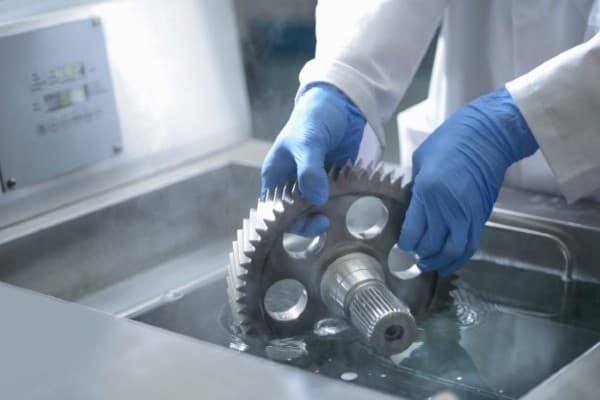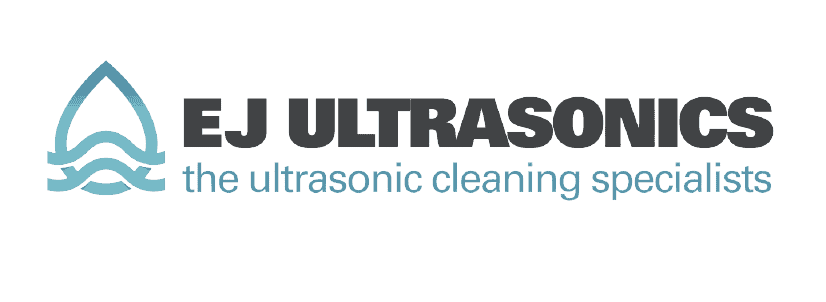If you have ever seen a video of an ultrasonic cleaning machine in action, then you will know that the cleaning process involves submerging an object into liquid. The machine then emits high-frequency sound waves to agitate the liquid and create cavitation bubbles, which quickly collapse with enough force to displace dirt and contaminants from the submerged object.
It’s a highly effective method for cleaning all manner of items, from jewellery and screw heads to musical instruments and car engine parts. However, the process would not be possible without that all-important liquid, also known as an ultrasonic cleaning solution.

What does the cleaning solution do?
As you may already be aware, the liquid used in ultrasonic cleaners does not consist solely of water. While water can remove some contaminants from the surface of certain objects, it’s not very effective by itself, which is why it’s typically mixed with a cleaning solution.
These solutions are designed to quickly and effectively clean stubborn dirt, such as grease, oil, lubricants and other contaminants, from a wide variety of materials, including glass, rubber, plastics and polished surfaces. Some concentrated solutions even include corrosion inhibitors, adding a layer of protection to your machine.
Ultrasonic cleaning solutions are typically made up of 10% concentrated cleaning fluid and 90% distilled or purified water, although tough cleaning jobs will require a higher concentration of chemicals.
Which cleaning solution is right for my ultrasonic cleaner?
Unsurprisingly, there are a huge variety of ultrasonic cleaning solutions available, and choosing the right one for your machine, and the items you’ll be cleaning, is very important.
You will first need to consider the type of contaminant you want to remove. Will your ultrasonic cleaner be used to remove blood from surgical or dental instruments, or general grime from jewellery? The type of cleaning solution you need will depend on the dirt you’re cleaning, and what you’re cleaning it from. For example, grease or oily substances will require a cleaning fluid with a degreasing formulation.
At EJ Ultrasonics, we recommend water-soluble detergents over harsh chemicals to break down contaminants. Aqueous ultrasonic cleaning solutions are water-based and solvent-free, and are the ideal partner for ultrasonic cleaning machines. They have a wide range of cleaning applications while reducing the environmental impact of industrial cleaning on water supplies.
Can I make my own ultrasonic cleaning solution?
Ultrasonic cleaners designed for commercial or industrial use will always require a special cleaning solution. However, ultrasonic cleaning machines have become increasingly popular for use at home and are available at a relatively low cost. These miniature machines are typically used for cleaning smaller items, such as glasses, jewellery, and coins.
While concentrated solutions are also available for these smaller units, effective cleaning fluids can be made at home using common ingredients. Popular solutions include a mixture of warm water with vinegar, soap, or vinegar. It’s important to always check the manufacturer’s instructions before using any homemade solutions.
How far should I fill my ultrasonic cleaning tank?
Overfilling your ultrasonic cleaner can result in your cleaning solution spilling out of the container due to the vibrations, which can damage the electrical components. Similarly, underfilling your tank can also result in damage to your machine, especially if it dries out.
You should fill your ultrasonic cleaner to the level recommended by the manufacturer. This will either be indicated on the machine itself or within the manufacturers’ instructions. If you’re unsure, we recommend filling the tank to roughly two-thirds of its total capacity, including the volume of the objects that you intend on cleaning.
It’s important to note that ultrasonic cleaners should never be operated without any liquid in the tank.
How often should the cleaning solution be changed?
Unfortunately, there is no hard or fast answer to this question, and, as with choosing the right solution for your machine, this will depend on a few different factors, including the size of your ultrasonic cleaning machine, how often you use it, and the type of objects it’s used to clean.
However, there are some indicators that your machine requires new cleaning fluid, the most obvious being that the liquid is visibly contaminated, and that the machine has become noticeably less effective. Other measures include a change in the speed of the ultrasonic waves passing through the liquid and a significant change in the liquid’s ph level.
How can an ultrasonic cleaner help your business?
The demand for ultrasonic cleaners is on the rise, and for good reason. There are a wide variety of benefits and uses for this type of equipment, however, it is still important to understand more about the process of ultrasonic cleaning.
At EJ Ultrasonics, we have more than 40 years of experience in the field of ultrasonic cleaning technology and are one of the leading manufacturers of ultrasonic cleaners in the UK. We’ve helped solve cleaning issues for household names such as Rolls Royce, Stryker, Specsavers, and many more. So, whether you’re cleaning precision watch parts or a carburettor caked with oil, we can offer you a solution tailored to your specific requirements.
If you want to find out more about ultrasonic cleaning solutions or would like some assistance with purchasing the right machine for your business, please get in touch to speak to a member of our expert team.


